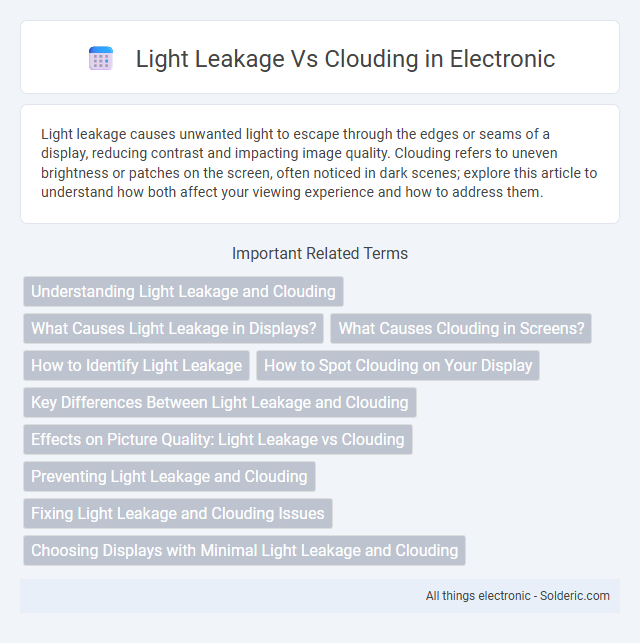Light leakage causes unwanted light to escape through the edges or seams of a display, reducing contrast and impacting image quality. Clouding refers to uneven brightness or patches on the screen, often noticed in dark scenes; explore this article to understand how both affect your viewing experience and how to address them.
Comparison Table
| Aspect | Light Leakage | Clouding |
|---|---|---|
| Definition | Unwanted light escaping from the edges or gaps of a display panel | Uneven brightness or haze on screen caused by pressure or manufacturing defects |
| Appearance | Bright spots or halos on dark backgrounds | Foggy or milky patches reducing screen clarity |
| Cause | Poor screen assembly or panel sealing | Panel pressure, backlight issues, or uneven liquid crystal distribution |
| Common in | LCD displays, especially IPS panels | LCD and OLED screens under stress or manufacturing errors |
| Impact on Viewing | Distracts in dark scenes, reduces contrast | Blurs image, decreases sharpness and color accuracy |
| Fixability | Often limited; may require screen replacement or resealing | Sometimes improved by pressure adjustment or component replacement |
Understanding Light Leakage and Clouding
Light leakage occurs when excess light escapes from the edges of a display screen, causing visible bright spots or patches, whereas clouding refers to uneven backlight distribution that appears as faint, cloudy areas on the screen. Both issues affect screen uniformity and viewing experience, but light leakage is typically more pronounced around screen edges, while clouding appears across the panel. Understanding these differences helps you identify and address display quality problems effectively.
What Causes Light Leakage in Displays?
Light leakage in displays is caused by uneven backlighting or manufacturing defects where light escapes through gaps or thin spots around the screen edges or between pixels. In contrast to clouding, which results from pressure or panel uniformity issues, light leakage primarily stems from poor assembly, faulty sealing, or inadequate diffusion layers in LCD displays. Understanding these causes helps You identify whether the issue is a structural problem or a panel uniformity flaw, guiding the appropriate display repair or replacement.
What Causes Clouding in Screens?
Clouding in screens is primarily caused by uneven distribution of the liquid crystals or backlight diffusion issues within LCD panels, resulting in brighter patches or spots on dark backgrounds. Manufacturing defects, panel pressure, and aging components can exacerbate this problem, affecting the uniformity of screen brightness. Your device's display quality can be compromised if clouding is significant, especially in low-light conditions where it becomes more noticeable.
How to Identify Light Leakage
Light leakage appears as unwanted bright spots or edges on your screen, especially visible in dark scenes, caused by gaps in the LCD panel's backlighting. Clouding manifests as uneven patches of brightness, often resembling foggy areas across the display, resulting from backlight bleed or panel inconsistencies. To identify light leakage, carefully observe your screen in a dark environment with a solid black image, noting any localized bright spots concentrated around the edges or corners.
How to Spot Clouding on Your Display
Clouding appears as uneven brightness or grayish patches on dark areas of your display, often visible in low-light scenes or dark backgrounds. Unlike light leakage, which is caused by backlight bleeding from the edges or corners, clouding manifests as diffuse, irregular blotches across the screen. To spot clouding on your display, observe a completely black or dark image in a dim room to detect inconsistent luminance or hazy spots that affect image uniformity.
Key Differences Between Light Leakage and Clouding
Light leakage occurs when unintended light escapes through the edges or seams of a display, causing uneven brightness or glowing spots. Clouding refers to the presence of irregular, cloudy patches on the screen due to backlight inconsistencies or pressure on the panel. The key difference lies in their causes and appearance: light leakage is associated with physical gaps and external light intrusion, while clouding results from internal panel issues affecting uniformity.
Effects on Picture Quality: Light Leakage vs Clouding
Light leakage causes uneven brightness and visible halos around the edges of the screen, which can distract from the overall viewing experience, especially in dark scenes. Clouding results in irregular patches or foggy areas that reduce contrast and obscure finer details, diminishing image clarity. Understanding how each issue affects your picture quality helps you make informed decisions when selecting or troubleshooting your display.
Preventing Light Leakage and Clouding
Preventing light leakage involves sealing gaps and edges in displays or devices to block unwanted light escape, improving image quality and user experience. Clouding prevention requires uniform backlight distribution and high-quality panel materials to avoid patches of uneven brightness. Your device's optimal performance depends on addressing both issues through precise manufacturing and quality control.
Fixing Light Leakage and Clouding Issues
Fixing light leakage and clouding issues involves carefully inspecting your monitor's panel for imperfect seals or pressure points causing uneven backlight distribution or discoloration. You can minimize light leakage by tightening bezel screws or applying light-blocking tape along panel edges, while clouding often requires professional calibration or replacing faulty layers within the display. Maintaining your screen under optimal settings and avoiding excessive pressure prevents worsening these common display problems, ensuring your visual experience remains crisp and consistent.
Choosing Displays with Minimal Light Leakage and Clouding
Selecting displays with minimal light leakage and clouding enhances your viewing experience by ensuring consistent brightness and uniform color across the screen. OLED panels and high-quality IPS LCDs often excel in reducing these issues through advanced manufacturing techniques and quality control. Prioritize reviews and technical specifications that highlight low light bleed and uniform backlighting to find the best display for your needs.
Light Leakage vs Clouding Infographic

 solderic.com
solderic.com